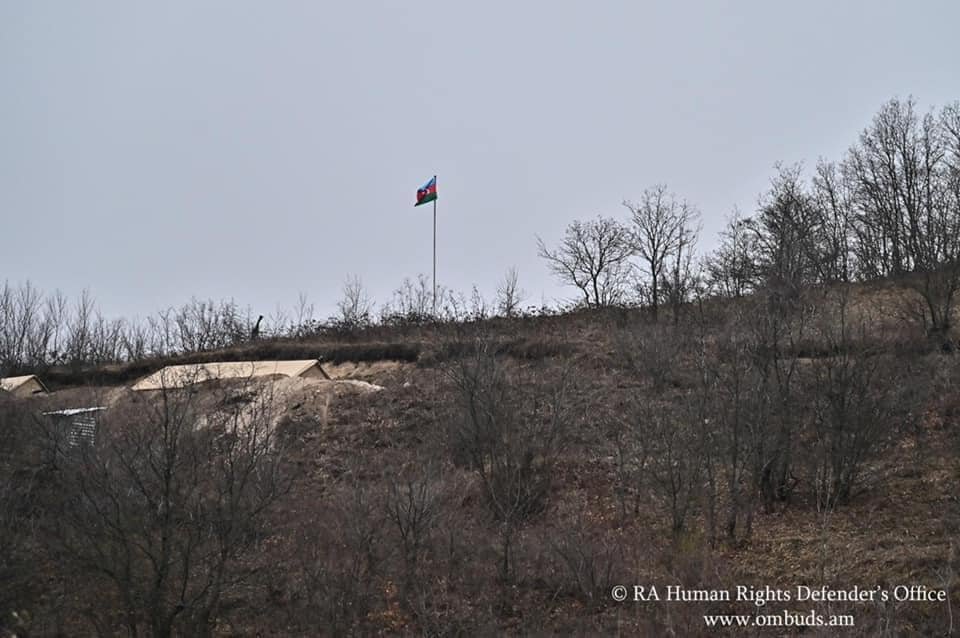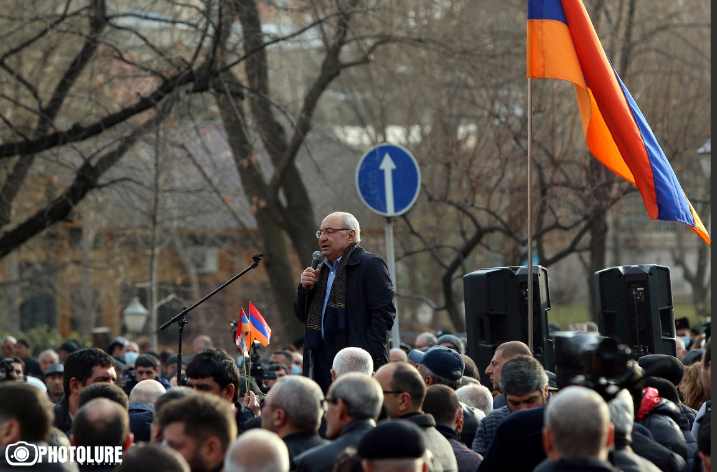Armenia’s Human Rights Defender Arman Tatoyan is advocating for the creation of a demilitarized security zone at least seven kilometers (four miles) wide in the southernmost Syunik province of Armenia. Since the signature of the November 9 agreement handing over extensive territory to Azerbaijan and delimiting a new international boundary, 39 settlements in Syunik and Gegharkunik have received the status of border communities. Residents now live side-by-side with Azerbaijan’s Armed Forces, as the areas where they conduct their daily activities are patrolled by Azerbaijani border guards.
The Human Rights Defender’s office has documented violations of the right to life, property and physical security in Syunik arising from the close proximity of villagers to Azerbaijani servicemen. For instance it has recorded several cases in which Azerbaijani soldiers have fired weapons in the immediate vicinity of villages including Agarak, Yeghivard, Srashen, Shikahogh and Nerkin Hand, where the Azerbaijani military outpost is located just 500 meters (about .3 miles) from the local school. People abstain from cultivating farmland directly under the aim of Azerbaijani troops in villages including Aravus, Khoznavar, Khnatsakh, Shournoukh and Davit Bek from fear of their physical safety, depriving them of their subsistence.

Moreover, the military notoriously places national flags and signposts as a pretext to deploy servicemen along the sections of roads that have fallen under Azerbaijani control. The border demarcation process does not adhere to the local geography, as the new boundary cuts through roads and entire villages. A four kilometer stretch (about 2.5 miles) of the major Yerevan-Kapan-Meghri highway was declared part of Azerbaijan, and different sections of the road are now patrolled by Azerbaijani, Russian and Armenian troops. Consequently, in villages including Shikahogh, Srashen, Chakaten, Nerkin Hand and Sznak, people avoid traveling at night to avoid encounters with Azerbaijani servicemen, even to go to the local hospital.
The border demarcation process has also divided villagers from land that for decades was used as pasture. People cannot access lands to which they have property titles issued by the Armenian government that are now officially part of Azerbaijan.

The obscure and controversial border demarcation process is rooted in a similar process that took place nearly 100 years ago following the Sovietization of Armenia and Azerbaijan. In 1923, following the annexation of Artsakh two years prior, the regions of Kelbajar, Lachin and Qubatlu were ceded to Soviet Azerbaijan for the formation of a province called Red Kurdistan. The new territorial unit, inhabited largely by Kurdish and Azeri people, separated Armenia from Artsakh by a four-mile buffer.
Similar to the modern day, the delimitation of a new boundary incited human rights concerns for residents of Armenian border communities, including cross-border attacks, theft of animals and restricted access to farmland. Local authorities disputed demarcation lines in several communities including Shvanidzor, Khoznavar and Kapan that would divide residents from lands necessary for pasture.
In 1930, further territories, including the Mets Al Lake and Pokr Al Lake and their pastures, were ceded to Soviet Azerbaijan, which invoked the needs of nomadic pastoralists of the Kurdish province. The lakes are located on the southern slopes of the Vardenis Range and northwest of the Syunik Plateau. The People’s Commissariat of the Republic of Armenia submitted a complaint for review of the decision. It argued that while the lakes were isolated from Soviet Azerbaijan, they provided critical water resources for agriculture in Basargechar (present-day Vardenis).
The decision was not reversed, and the lakes remained under Azerbaijani jurisdiction. Later that year the idea of establishing a Red Kurdistan was abandoned. However, none of the previously yielded lands were formally returned to Soviet Armenia.
Several of the ceded territories, including the Al Lakes, are depicted as integral parts of Soviet Armenia in maps published in the 1920s. However, later maps do not depict the territorial changes from the end of the decade.
In the 1990s during the First Artsakh War, the Armenian military regained control over the territory of the short-lived Red Kurdistan. These lands were recently recaptured by Azerbaijan as a result of the 2020 Artsakh War. The subsequent border demarcation process represents the first time that the issue of delimiting the official Armenian-Azerbaijani international boundary has been visited since the 1920s. Since the 1990s, the border between Armenia and its buffer zone has been considered porous, as locals have easily crossed the border in order to graze their animals. Today authorities utilize century-old maps and GPS systems to revive boundaries arbitrarily drawn 100 years ago by Soviet officials.
According to Tatoyan, the border demarcation process should be humanized with an adherence to the lived realities on the ground and the rights of the inhabitants of border communities. He argues that cadastral documents should form the basis of the process in order to protect the property rights of local residents. Defending property titles, while establishing a demilitarized zone in Syunik, would guarantee the rights to life, property and physical security in a region where daily life has been upended by the war.
Meanwhile the political crisis in Armenia continues as the opposition blockaded the parliament building this week to demand that members of parliament support the removal of Prime Minister Nikol Pashinyan from office. Anti-government protests have been constant since the PM’s signature of the ceasefire agreement ending the 2020 Artsakh War. Followers of the Homeland Salvation Movement have shut down the major Baghramyan Avenue since February 25, when the military brass released a statement joining the ranks of the opposition forces in calling for the PM’s resignation.
Thousands of protesters gathered to block the entrances to the National Assembly Building in response to a call on Tuesday evening from Vazgen Manukyan, the candidate selected by the movement to lead an interim government of national unity that would organize snap elections. “We are surrounding the National Assembly. The National Assembly will only work when it accepts a decision suitable to the people,” he declared. “Until then we must close the entrances, and afterward we can continue our discussion.”
Coordinator of the Homeland Salvation Movement Ishkhan Saghatelyan stated that they have no intention of storming parliament, but would stop the MPs from entering the National Assembly, because “they have nothing to do there.” Demonstrators set up two tents on Demirchian Street to prevent entry to the building.

The opposition has also been insisting that the president overturn Pashinyan’s order to dismiss Chief of the General Staff of the Armed Forces Onik Gasparyan. On Wednesday morning Pashinyan announced that Gasparyan had officially been dismissed from his post.
Pashinyan issued a dismissal order for Gasparyan after accusing the General Staff of a “military coup attempt.” According to Articles 14 and 155 of the Armenian Constitution, the Armed Forces must maintain neutrality in political matters as they are under the subordination of the government and civilian control. President Armen Sarkissian disclosed that he would apply to the Constitutional Court to question the constitutionality of the Law on Military Service and the Status of Servicemen under which the PM dismissed Gasparyan. He did not dispute the draft decree itself, however, allowing the decree to come into force.
In response to the PM’s announcement, Gasparyan denounced “both the published statement and the whole process of dismissal” as unconstitutional, sharing that he had challenged the order in the Administrative Court.

In an interview with Nayiri Mgrdichian and Narine Doumanian for the Armenian Weekly, political scientist Vartan Boghossian argued that the president should have challenged the decree in the Constitutional Court from the very beginning on the grounds of its unconstitutionality.
“According to the Law on Defense, the Chief of the General Staff of the Armed Forces is appointed for a term of five years and until the end of his term, no one has the right to dismiss him from that position,” Boghossian said. “The Constitution guarantees that the Chief of the General Staff is irreplaceable. He cannot be removed from office for any political reason.”
“When the President of the Republic took the first step and pointed out to the Prime Minister that his proposal to dismiss the head of the General Staff contradicts the Constitution, he was obliged to immediately apply to the Constitutional Court, which he did not do,” he continued.
The PM has submitted a motion to the President to appoint Artak Davtyan to the post of the Chief of the General Staff of the Armed Forces. Davtyan previously held the position from 2018-2020.
In spite of this latest development, the opposition movement plans to carry on its demonstrations. “Onik Gasparyan is gone, but we continue our fight,” Manukyan proclaimed during Wednesday’s rally.



More great writing. The American University of Armenia has Geographic Information Systems (GIS) and the ability to draw accurate maps. I see that topic as vital for boundary definition and recognition, and the definition of demilitarized zones that factor in the range of missiles.
Richard, I think the dictator of Azerbaijan using Israeli made GPS for the creation of another war and more military hardware sale to the corrupt dictator. Israeli thirsty military companies need to sell war materials, otherwise, they will end up in bankruptcy.
GB: No disagreement with the ugly realities and overwhelming economic, technological and military power behind the dictator. Russia is providing some level of immediate protection, and prevented an ugly war from being even worse with direct attacks on Metzamor for example. I was merely thinking that the boundaries of mountainous Artsakh are still undefined, and that OSCE might wake up to protection of a demilitarized zone there if they knew where and what it was!